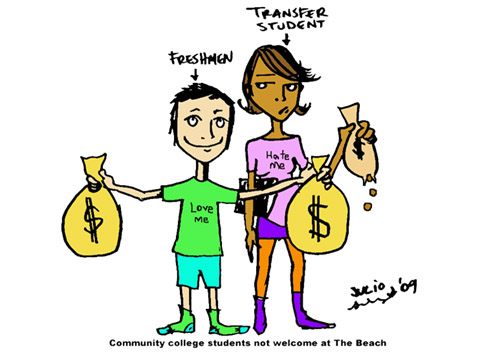This campus has many students with vastly different backgrounds. Some of us have been here since our freshman year, some are transfer students, some work part-time and some don’t work at all. Whatever our differences may be we all have one thing in common; we are in pursuit of a higher education — we are here.
It hasn’t been easy for many of us to get to this campus and, for those who have by way of transfer, it hasn’t been easy getting here at all. We’ve spent an average of two to three years in college already.
If we seek a higher education the main reason was our hard work — or so we are told. Work hard, study, get good grades and college opens its doors. We all know there is some truth to that, but in the face of a money-less California, for how long?
In the past, the Daily Forty-Niner has reported enrollment for Cal State Long Beach will be capped, something that has never been done before. There will be fewer incoming students in the semesters to come because there is no room for them, or money to cover increasing costs.
But how do you decide who gets in and who stays out?
Well, it seems if you are the university administration — whose mission is to offer affordable education to all who qualify — you pick the students that will make the university more money.
Who are these moneymaking machines? Freshmen. They and their parents promise four or more years of housing cash, tuition and “I heart The Beach” regalia. Transfer students tend to be more cash conscious and are only here for around two years.
That’s right kids, it comes down to the almighty buck as to who gets in and who doesn’t. It’s not surprising the decision of who to take and who to put on a waiting list is based on dough. We have a chancellor who gave back badly needed funds because the governor asked him to. We have a state legislature that balances its budget chicanery on the back of higher education.
Students who have been told they “can do it” will be turned away. These are students who are being thrown a gigantic roadblock in the middle of their educational road. If they cannot transfer, then what are they going to do? Stay at the community college they are trying to get out of? A place that boasts crammed classrooms, where window seals become desks and 100-student wait lists are becoming commonplace?
Those problems will exacerbate as the newly planned cuts hit all levels of education, including community colleges. They will have to kick people out.
If you can’t go up, there is nowhere else to go but down — or out. In essence, they will always be waiting to get in — well some of them at least. Others will just give up; stop in the midst of a college education because they can’t fit.
Whereas, when a freshman is turned away there are other options; maybe take a year or a semester off, or go to a community college. They have not yet started so it seems it would be a smarter and fairer way to delay 18 year olds instead of blocking 20-30 year olds.
California will never find our feet again if we fail to support education. What this economy needs is a highly educated workforce, not a poorly educated hard-to-hire workforce.
According to a report, Effective Strategies to Aid Low-Income and Minority Students by policy analyst Jennifer Dounay, college diplomas pay more taxes at both federal and state levels. The majority of transfer students come from minority and low-income households.
The restrictions announced last week by CSULB to not allow any transfers in spring 2010 and greatly restrict them in the fall will only contribute to the struggle to education achievement.
Dounay points out that by 2050, minorities will make up the majority and “lower college completion rates among minorities pose a serious economic development issue.”
This means the majority of the population will be earning less because they are uneducated. Meaning they will possibly need government assistance. Meaning their kids will be in the same place they were.
Can anybody in good conscience envision a low-educated, minority caste of indentured servants as a menial-wage earning labor force?
It seems our administrators can and it seems it’s been done before. That problem was supposedly solved with the end of the Civil War.




